|
(article published by Charles H. Pankey in "The Journal of the Orders
and Medals Society of America (November 1997)", Vol 48, No. 9)
The country of Romania has a rich and colorful history in the field of aviation.
Their aeronautic achievements of self-powered aircraft date from 1903 when the Romanian
engineer Traian Vuia introduced a design of what he described as a "car airplane" to the
French Science Academy. This was approximately two months prior to the Wright brothers'
first flight near Kitty Hawk, North Carolina, on December 17, 1903. The Board of the
French Science Academy considered the design of Vuia and referred to it as highly
improbable. Undeterred by this rejection, Vuia later achieved flight with a heavier than
air aircraft using solely its own power on March 18, 1906. The aircraft was designed,
built and piloted by him.
Romanian Junior Lieutenant Henri Colanda was one of the first individuals to design
and build a "jet engined" airplane. On December 16, 1910 the craft was tested for the
first time. While the aircraft was warming up for other than a scheduled flight, it
began moving and took off by its own means. After it achieved flight, it ultimately
plummeted back to the ground with sufficient force to destroy the craft. One must consider
that if you have never flown, certainly you have no experience in landing!
The initial date of the Romanian Air Force is said to be June 17, 1910 when an aircraft
contracted by the Romanian Ministry of War was successfully tested.
On April 1, 1913 the Romanian Parliament began structuring laws for military aviation
thereby paving the way for the Air Force as an independent branch. The Romanian Air Force
had at least 18 aircraft in the Second Balkan War (June-August, 1913). On August 15,
1915 the Romanian Air Corps was established with three groups and a squadron for special
missions.
During World War I the Romanian Air Force engaged in combat facing both German and A
ustro-Hungarian forces. Subsequently there were campaigns against the Bolsheviks in
Hungary and Bessarabia.

Photo courtesy of Charles H. Pankey
During World War II, Romania first allied itself with Germany and the Air Force saw
combat in the invasion of Russia and against the Allied raids. After the coup d'etat by
King Michael I in 1944 ousting Marshal Ion Antonescu from power, the Romanian Air Force
joined with the Allied powers and fought for the liberation of Transylvania, Hungary and
Czechoslovakia.
PILOT/OBSERVER BADGES
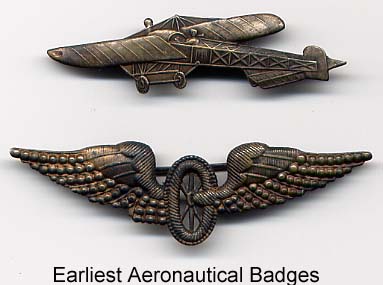
Photo courtesy of Charles H. Pankey
The earliest military pilot insignia consisted of a badge in the shape of an aircraft
resembling the French Bleriot XI. (The Bleriot XI conducted the first cross-channel
[English Channel] heavier than air flight on July 25, 1909.) This badge was worn on the
collar of the uniform. After the reign of King Carol I (1866-1914), military aviation
insignia consisted of a pilot badge and aerial observer badge. The aerial observer
essentially assisted the pilot in navigation and also controlled the armament on the
airplane whether it be machine guns or bombs. This second type military pilot insignia
consisted of an eagle with its wings upraised, standing on a sphere with the superimposed
inverted cipher of Ferdinand I under crown. The Aerial Observer Insignia consisted of the
Ferdinand I inverted cipher under Crown with upraised wings attached thereto.
The size was approximately 44 mm wide and 57 mm high for the pilot's badge and 40 mm wide
and 49 mm high for the observer badge. The insignia primarily was made of white metal and
photographs of military personnel indicate it was worn on the upper right breast.
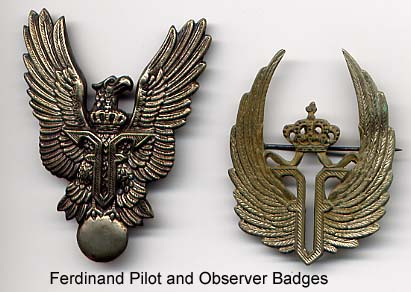
Photo courtesy of Charles H. Pankey
After the reign of King Ferdinand (1914-1927) and upon King Carol II taking the throne,
the military pilot and observer insignia were changed wherein instead of the cipher of
Ferdinand there was the Romanian coat of arms and crown in gilt and enamel. The badges
were made of both silver and bronze. During the reign of Michael I (1940-1947), the
badges were again changed wherein instead of the coat of arms there was a cross under
crown with the construction being both in silver and bronze.
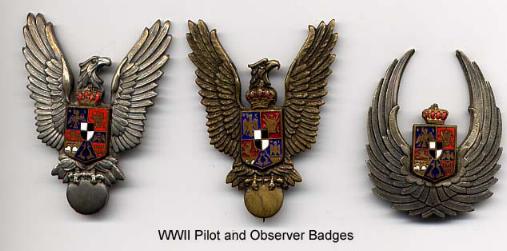
Photo courtesy of Charles H. Pankey
AERONAUTICAL VIRTUE ORDER
In 1930 King Carol II established an Order exclusive to aviation. The
Aeronautical Virtue Order (Virtutea Aeronautica) was instituted by
Royal decree No. 2895 of July 31, 1930 and awarded only to air personnel, both civilian
and military who distinguished themselves in service and contributed to the advancement
of aeronautics in times of peace or war. Posthumous awards were also allowed.
The Order had four grades: commander, officer, knight and golden cross. The grades
differed in size, construction, and the manner in which they were worn. The commander
was approximately 58.5 mm in diameter and was worn on a ribbon at the throat, while the
officer and knight grades were approximately 43 mm in diameter and worn on a narrow
ribbon on the left breast. The golden cross was approximately 42.5 mm in diameter and,
likewise, worn on a narrow ribbon on the left breast.
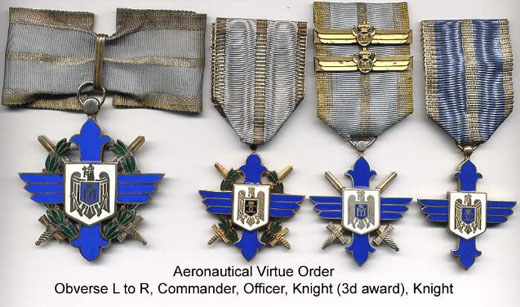
Photo courtesy of Charles H. Pankey
Military pilots who were decorated with the third class Order of the sparingly
awarded Romanian Order of Michael the Brave were also entitled to the knight grade of
the Aeronautical Virtue Order.
The Order consisted of a cross with a longer vertical limb shaped as a trefoil and the
shorter horizontal limb designed as a stylized wing. In the centre of the obverse there
was a gilt shield with the crowned and armed eagle of Romania's coat of arms. The eagle
had the crowned cipher of King Carol II superimposed on its chest. The commander grade
was as above and was further superimposed over a green enamel wreath of laurel leaves
edged in gilt and joining the top trefoil. The knight and officer grade were distinguished
by the officer grade having the same green wreath and the knight grade being without the
wreath. On the reverse which is in enamel and gilt was written the date of institution of
the Order: "1930". The war version had two crossed swords in gilt between the limbs of
the cross. The "golden cross" grade was made of gilt while the others were of dark blue
enamel with a white shield edged and lined in gilt.
The approximately 38 mm wide ribbon (the commander cravat was 40 mm wide with 5.5 mm
center and edge stripes) was made of light blue moire with 3 mm silver stripes in the
middle and along the borders. Under a royal decree of December 19, 1938 the ribbon was
changed with a variant of two 3 mm golden thread stripes along the edge of the ribbon
which could be awarded as a war ribbon.
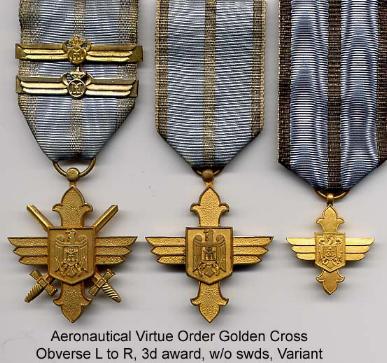
Photo courtesy of Charles H. Pankey
If the Knight grade and Golden Cross grade were awarded a second or third time, one or
two bars respectively could be added to the ribbon. The bars were approximately 40 mm
wide and 10 mm high in the center and were silvered for subsequent Knight awards and gilt
for subsequent Golden Cross award.
After the Order had been awarded several times, the metal insignia was replaced by
shoulder straps made of gilt in the shape of a stylized wing with King Carol II's crowned
cipher in the middle.
After the abdication of Carol II and the succession by his son, Michael I, the only
change in the Order was the cipher of King Carol II was changed to the cipher of Michael I.
Manufacturers of the Order are said to include Rudolf Souval of Vienna and Fa. Karnet
of Prague. The Author has not noticed any hallmarks on any orders.
AERONAUTICAL VIRTUE MEDAL
In 1931 King Carol II also established the Aeronautical Virtue medal which was related
exclusively to aviation. The medal was instituted by Royal decree No. 463 of February 24,
1931 to be awarded to air personnel in time of peace and time of war in recognition of
valor and gallantry in battle. The medal had three classes: 1st, 2nd and 3rd. The
circular medal was 33 mm in diameter and had a slightly raised border. The obverse showed
the profile of a young woman looking to the right, with her hair flying in the wind and
wearing a winged helmet. The reverse shows Romania's coat of arms (model 1921) on the
upper portion, flanked on both sides by a small stylized wing. A three quarter wreath of
laurel leaves, tied at three places joins the lateral wings of the coat of arms. In the
center of the medal the inscription "PENTRV AERONAUTICA, 1931" was written.
The 35 mm wide ribbon was made of light blue moire with a 5 mm silver stripe in the
middle.
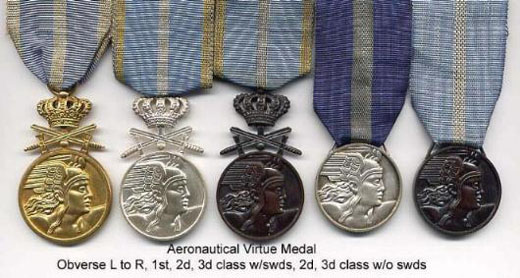
Photo courtesy of Charles H. Pankey
On December 19, 1938 the medal was raised to the status of a decoration for bravery
and could be awarded with swords which would include the addition of 3 mm wide golden
stripes on the edge of the ribbon. The 1938 type was surmounted by two 28 mm crossed
swords and a 20 mm royal crown.
The Order and medal became obsolete in 1947 with the formation of the People's
Republic of Romania. The basic design of the pilot badge continued except the Republic's
emblem replaced the prior Royal Coat of Arms.
© Copyright 1997 Orders and Medals Society of America and Charles H. Pankey.
All rights reserved. Reproduced by Permission
Bibliography:
- Aeronautica Magazine - Special Issue May, 1995
- Aeronautica Magazine - Nr. 9, 1996
- Klietmann, Dr. Kurt-Gerhard. Phaleristik Rumänien (Berlin, 1975)
- Safta, Jipa, Velter & Marinescu. Decoratii Românesti De Razboi (1860-1947)
(Bucharest, 1993)
- Stefan, Neculae & Dumitrascu. Romania Decoratii (1859-1991) (Bucharest, 1992)
Special thanks to Mark and Carmen Paterson and Dan Dimitrescu of Bucharest, Romania
for their research assistance. |